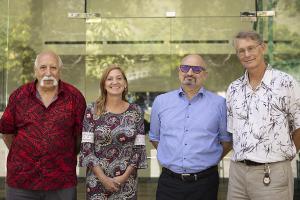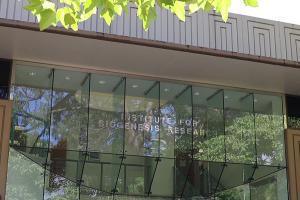$5.3M funding for world famous reproductive science lab at UH
Newest grant will advance work of scientists who produced “glowing green mice
University of Hawaiʻi at MānoaThe University of Hawaiʻi Mānoa (UHM) has received a $5.3 million grant to continue research at the laboratory that became world-famous for producing mice and eventually other animals that glow green under ultraviolet light. This grant will allow the Institute for Biogenesis Research (IBR) to produce transgenic mice for other researchers seeking medical cures at UH.
The mouse and its pups glowed green because jellyfish genes had been inserted into a mouse embryo to demonstrate the lab’s successful technique for inserting DNA from an unrelated organism into that of another animal. The first green mouse was born, and then she transferred the glowing gene to her pups.
This is the third consecutive five-year funding award the IBR has been selected to receive.
“All along, we've been developing new technologies to make us even better,” said Steven Ward, PhD, Director of the IBR. “With this grant, we'll be able to build on our previous 10 years of research to provide genetically altered mice for anybody at UH. These are models that scientists can use for their research -- mice with specific diseases or with a certain gene missing or with a gene present so the researchers can see what they can do with it.”
Since mice are the closest animals to humans for biological testing, Dr. Ward said, making a better mouse models allows scientists to advance cures.
The federal funding from the National Institutes of Health (NIH), Institutes of General Medical Sciences (NIGMS) will support collaborations between the IBR, part of the UHM John A. Burns School of Medicine, and its Reproductive Biology Departments of Anatomy, Biochemistry & Physiology and Obstetrics, Gynecology & Women’s Health.
Multimedia Elements include video and selected high resolution still photographs https://spaces.hightail.com/space/5JfdA5ORcu
Video News Release Elements
:00 SOT FULL
##Steven Ward, PhD ##UH Institute for Biogenesis Research
“So over the last 10 years we didn’t just make the green mouse and leave it there for 10 years we’ve been developing new technologies these to make us even better. So this year with this grant we'll be able to use that ten years of research to provide mice for the for anybody at UH who needs it with particular gene in it that we know where it can go and what we can do with it.” :32
B-Roll video
:32 Still of the “glowing green mouse with her pups”
:41 pullout of the still of green mouse and pups
:51 an IBR researcher working with a microscope
1:13 IBR researcher using a pipette to fill petri dish will organic material and then liquid
1:48 researcher focuses on microscope then moves samples to fridge
2:01 video of mice (regular colored ones) at play in the vivarium
2:16 exterior still shot of the IBR building at UH Manoa
2:27 slow zoom into the exterior still shot
2:35 ends
Suggested video version news release
$5.3M FUNDING FOR WORLD FAMOUS REPRODUCTIVE SCIENCE LAB AT UH
Newest grant will advance work of scientists who produced “glowing green mice,” laid groundwork for invitro fertilization
The University of Hawaiʻi has received a $5.3 million grant to continue research at the laboratory that became world-famous for producing mice and other animals that glow green under ultraviolet light.
Voiceover
This grant will allow the Institute for Biogenesis Research to produce transgenic mice for other researchers in Hawaii.
The “glowing” feature came about when jellyfish genes were inserted into a mouse embryo to show that the lab’s method for inserting DNA from an unrelated organism into other animal worked. A glowing green mouse was born, and she transferred the glowing gene to her pups, too.
Dr. Ward sound on tape
“Over the last ten years we didn't just make the green mouse and leave it there we've been for ten years we've been developing new technologies to make us even better. So this year with this grant we'll be able to use that ten years of research to provide mice for the for anybody at UH who needs it with particular gene in it that we know where it can go and what we can do with it.”
Voiceover
Ward says mice are the closest scientific models to humans, so better mice models can help speed human cures.
(Photographs are described on release but also available full-size in https://spaces.hightail.com/space/5JfdA5ORcu )
###



